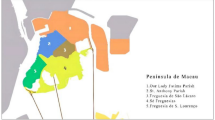Abstract
This paper presents a simple, analytically solvable, dual-space economic agglomerations model which, like Krugmann’s model, contains two agglomerative forces. However, in contrast to that model, two agglomerative forces are technological externalities and transaction costs rather than labor division and transaction costs. Moreover, the present model exhibits ‘learning by transacting’ of the technological externalities rather than ‘learning by doing’. This may be a better description for some agglomerative processes in the network age than complete agglomeration in the Industry Age predicted by Krugmann’s model.
Similar content being viewed by others
References
Acemoglu D (2002) Technical change, inequality and the labor market. J Econ Lit 40:7–72
Acemoglu D, Pischke D (1999) The structure of wages and investment in general training. J Polit Econ 107:539–572
Aerts ATM, Szirbik NB, Goossenaerts JBM (2002) A flexible, agent based ICY architecture for virtual enterprises. Comput Ind 49:311–327
Almazan A, de Motta A, Titman S (2003) Firm location and the creation and utilization of human capital. NBER Working Paper vol. 10106
Audretsch DB, Feldman MP (2004) Knowledge spillovers and the geography of innovation. In: Thisse JF, Henderson JV (eds) Handbook of regional and urban economics. Cities and geography. vol. 4. North Holland, Amsterdam, pp 2713–2739
Becker G (1964) Human capital. The University of Chicago Press, Chicago
Brunello G, Medio A (2001) An explanation of international differences in education and workplace training. Eur Econ Rev 45:307–322
Castells M (1999) The informational city, information technology. Economic restructuring and the urban–regional process. Blackwell, Oxford, p 272
Castells M (2001) The rise of the network society. Social Science Literature Publishing House, Beijing, pp 74–75, 192, 536 (In Chinese)
Chatterjee K, Samuelson W (1983) Bargaining under incomplete information. Oper Res 31:835–851
Ciccone A, Hall R (1996) Productivity and the density of economic activity. Am Econ Rev 86:54–70
Combes P, Duranton G (2006) Labor pooling, labor poaching and spatial clustering. Reg Sci Urban Econ 36:1–28
Eaton J, Eckstein Z (1994) Cities and growth: theory and evidence from France and Japan. NBER Working Paper No. 4612, pp 235–267. http://www.nber.org/paper/w
Fujita M, Krugman P (1995) When is the economy monocentric: Von Thunen and Chamberlin Unified? Reg Sci Urban Econ 25:505–528
Fujita M, Krugman, P, Venables AJ (1999) The spatial economy: cities, regions and international trade. MIT Press Cambridge, MA, p 87
Fuller T (2003) If you wanted to know the future of the small business what question would you ask? Future 35:305–321
Glaeser E (1999) Learning in cities. J Urban Econ 46:254–277
Glaeser E, Kallal H, Scheinkman J, Shleifer A (1992) Growth in cities. J Polit Econ 100:1126–1152
Greve A (1995) Networks and entrepreneurship---an analysis of social relation, occupational background, and use of contacts during the establishment process. Geoforum 1:1–24
Henderson V, Kuncoro A, Tuner M (1995) Industrial development in cities. J Polit Econ 103(1995):1067–1090
Krugman P (1991a) History vs. expectations. Q J Econ CVI:651–667 (National Bureau of Economic Research Paper No. 2971, May 1989)
Krugman P (1991b) Geography and trade. MIT, Cambridge
Krugman P (1996) The self-organizing economy. Blackwell, Cambridge, p 58
Lambooy JG (1997) Knowledge production, organization and agglomeration economies. Geojournal 41(4):293–300
Leon Oerlemans AG, Manrius Meeus TH, Frans Boekema WM (2001) Firm clustering and innovation: determinants and effects. Pap Reg Sci 80:337–356
Maillat D (1991) The inovation pocess and the rule of the milieu. In: Bergman E, Maier G, Todtling F (eds) Regions reconsidered: economic networks, innovation and local development in industrialized countries. Mansell, London
Martinez MT, Fouletier P, Park KH, Favrel J (2001) Virtual enterprise—organization, evolution and control. Int J Prod Econ 74:225–238
Nash J (2000) Papers of game theory of Nash. Capital Economic and Trade University Publishing House, Beijing (In Chinese) 2000 Edition
Nilles J (2000) What’s telework, JALA International Inc. Available at: www.jala.com/definitions.htm
Pryor PL (2001) Will most of us be working for giant enterprises by 2028. J Econ Behav Organ 44:363–382
Rosenthal S, Strange W (2003) Geography, industrial organization and agglomeration. Rev Econ Stat 85:377–393
Rosenthal S, Strange W (2004) Evidence on the nature and sources of agglomeration economies. In: Thisse JF, Henderson JV (eds) Handbook of regional and urban economics cities and geography. vol. 4. North-Holland, Amsterdam, pp 2119–2171
Rotemberg JJ, Saloner G (2000) Competition and human capital accumulation: a theory of interregional specialization and trade. Reg Sci Urban Econ 30:373–404
Saxenian A (1991) The origins and dynamics of production networks in Silicon Valley. Res Policy 20:423–437
Scott AJ (1988) Metropolis from the division of labor. University of California Press, Berkeley, California, p 15
Scott AJ (1993) Interregional subcontracting patterns in the aerospace industry: the Southern California nexus. Econ Geogr 69:142–156
Scott AJ (1996) Regional motors of the global economy. Future 28(5):391–411
Stevens M (1994) An investment model for the supply of training by employers. Econ J 104:408–419
Wick D (2002) Successfully increasing technological control through minimizing workplace resistance: understanding the willingness to telework. Manage Decis 40/7:672–681
Yang XK, Huang YG (1999) Specialization and economic organization. Economic Science Publishing House, Beijing (In Chinese) 1999 edition
Zhang W-Y (1996) Game theory and information economics. ShangHai People Publishing House, Shanghai (In Chinese) 4
Acknowledgements
The authors thank two reviewers especially the reviewer no.2 who made a substantial help, by editing and correcting the whole paper. We acknowledge editors of this journal and reviewers’ valuable comments and precious cooperation.
Author information
Authors and Affiliations
Corresponding author
Rights and permissions
About this article
Cite this article
Shi, Z., Wen, Z. & Xia, J. A Simple, Analytically Solvable, Dual-Space Economic Agglomerations Model. Netw Spat Econ 10, 261–271 (2010). https://doi.org/10.1007/s11067-008-9069-4
Published:
Issue Date:
DOI: https://doi.org/10.1007/s11067-008-9069-4




